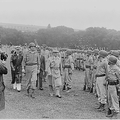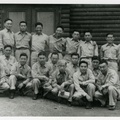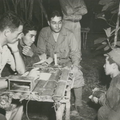Five thousand Japanese Americans were in the US Army when WW II began on December 7, 1941. LTG John DeWitt, Military Governor of America’s Pacific coast, who questioned the loyalty of all ethnic Japanese, unilaterally discharged the Nisei in his zone and many went to internment camps with their families.
In Hawaii, 1,432 Nisei were soldiers in the 298th and 299th Regiments of the Hawaii National Guard, which were comprised of all ethnic groups. Because the Nisei were viewed as a security threat, LTG Delos C. Emmons, Military Governor of Hawaii, who faced an imminent threat of land invasion by Japan, decided to transfer these Nisei into the newly formed Hawaiian Provisional Infantry Battalion, and shipped them to Oakland, CA on June 12, 1942.
Discharging them from the Army in Hawaii would not be enough. While some local officials vouched for the loyalty of Nisei soldiers, Washington’s concern was that discharged Nisei might bear arms or support the invading Japanese force or the Imperial Japanese soldiers would disguise themselves as Nisei. When the Nisei reached Oakland their unit name was changed to 100th Infantry Battalion (Separate) and they were placed on a train for Camp McCoy, Wisconsin for training.
During the 100th’s training, their letters were reviewed, in part, to evaluate their loyalty and the Army Inspector General (IG) conducted a special review on Nisei loyalty. The IG was favorably impressed on this point as was General George C. Marshall, the Army Chief of Staff, who witnessed the 100th’s final maneuvers, on the 100’s combat readiness. These favorable assessments of the 100th, no doubt, factored into Washington’s decision to form the 442nd Regimental Combat Team.
In addition to running America’s global war, Marshall was deeply concerned about the “Japanese issue”, i.e. how to bring the ethnic Japanese into America’s mainstream after the war ends. He must have felt that a strong combat performance by a larger all Nisei unit was needed to convince the American public to accept Japanese Americans.
This view is reflected in Assistant Secretary of War John J. McCloy’s statement to Mike Masaoka, who had advocated that Japanese Americans serve in non-segregated units. McCloy said Nisei acts of heroism would be diffused in large Caucasian units and felt a segregated racial unit could best tell their story. Masaoka agreed with this rationale and a call went out to the Nisei community for volunteers to form the 442nd Regimental Combat Team. 2,500 volunteers were accepted from Hawaii and 1,500 volunteered from the mainland, many from internment camps. Niseis saw this as an opportunity to prove their loyalty.
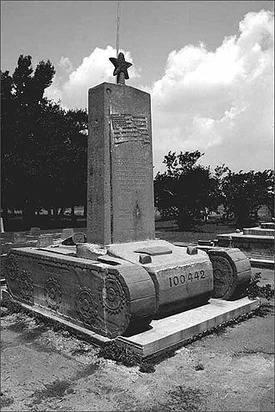
It could be surmised that the merger of the 100th into the 442nd RCT was pre-designed. When the 100th needed replacements, they were sent from the 1st Battalion of the 442nd RCT which was training at Camp Shelby, MS. In June 1944 the 442nd, minus the first Battalion, arrived in Civitavecia, Italy, where the 100th merged into the 442nd becoming, in effect, its 1st Battalion. The 100th, however, retained its unit designation. By then, only a small number of members of the original 100th BN members were serving in the once all Hawaiian Nisei unit.
Following General Marshall’s retirement from public service, he displayed amazing recall of the 100th and the 442nd to his biographer, Forrest C. Pogue. In response to Pogue’s question, Marshall said when the 100th was ready for deployment, a proposal was made to SHAEF headquarters, however, Supreme Allied Commander General Dwight Eisenhower’s staff declined the offer. The offer was then made to LTG Mark Clark, commander of the 5th Army in Italy, who accepted. In confirming the assignment, Marshall requested that he be kept informed of Nisei performance.

Marshall continued, “... then we finally built this [100th] up into a regiment [442nd RCT] ... I will say about the Japanese fighting in these units we had: they were superb! That word correctly describes it: superb! They took terrific casualties. They showed rare courage and tremendous fighting spirit. Not too much can be said of the performance of those battalions in Europe and everybody wanted them ... in the operations, and we used them quite dramatically in the great advance in Italy which led up to the termination of the fighting there [Po Valley campaign]. I thought the organization of the additional [442nd] battalions was very essential because we felt that unless we did something about the Japanese in this country, we would have a very hard time afterwards. I don’t mean [with] the Army. I mean the civil population. As a matter of fact, even with their brilliant performance, some communities rather blackballed the men when they came home as veterans.” This remarkable recall of detail is from the man who ran the war in Europe and the Pacific.
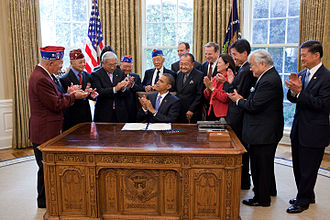
Today, the 100th Battalion, 442nd Infantry continues as a National Guard unit in Hawaii and has served two deployments to the war zone in the Middle East.
*This article was originally published in JAVA Advocate in Winter 2016-2017.
© 2019 JAVA Research Team



